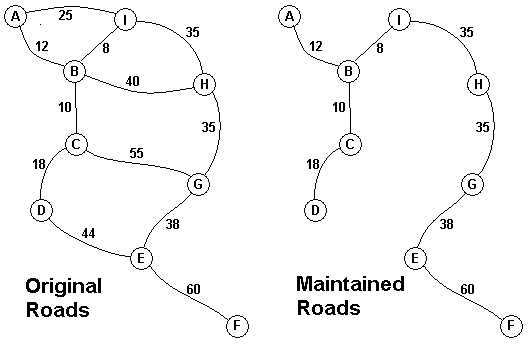POJ 1251 Jungle Roads(最小生成树)
来源:互联网 发布:西亚斯网络管理中心 编辑:程序博客网 时间:2024/05/16 03:57
Jungle Roads
Time Limit: 1000MS Memory Limit: 10000KTotal Submissions: 23272 Accepted: 10864
Description

The Head Elder of the tropical island of Lagrishan has a problem. A burst of foreign aid money was spent on extra roads between villages some years ago. But the jungle overtakes roads relentlessly, so the large road network is too expensive to maintain. The Council of Elders must choose to stop maintaining some roads. The map above on the left shows all the roads in use now and the cost in aacms per month to maintain them. Of course there needs to be some way to get between all the villages on maintained roads, even if the route is not as short as before. The Chief Elder would like to tell the Council of Elders what would be the smallest amount they could spend in aacms per month to maintain roads that would connect all the villages. The villages are labeled A through I in the maps above. The map on the right shows the roads that could be maintained most cheaply, for 216 aacms per month. Your task is to write a program that will solve such problems.
Input
The input consists of one to 100 data sets, followed by a final line containing only 0. Each data set starts with a line containing only a number n, which is the number of villages, 1 < n < 27, and the villages are labeled with the first n letters of the alphabet, capitalized. Each data set is completed with n-1 lines that start with village labels in alphabetical order. There is no line for the last village. Each line for a village starts with the village label followed by a number, k, of roads from this village to villages with labels later in the alphabet. If k is greater than 0, the line continues with data for each of the k roads. The data for each road is the village label for the other end of the road followed by the monthly maintenance cost in aacms for the road. Maintenance costs will be positive integers less than 100. All data fields in the row are separated by single blanks. The road network will always allow travel between all the villages. The network will never have more than 75 roads. No village will have more than 15 roads going to other villages (before or after in the alphabet). In the sample input below, the first data set goes with the map above.
Output
The output is one integer per line for each data set: the minimum cost in aacms per month to maintain a road system that connect all the villages. Caution: A brute force solution that examines every possible set of roads will not finish within the one minute time limit.
Sample Input
9A 2 B 12 I 25B 3 C 10 H 40 I 8C 2 D 18 G 55D 1 E 44E 2 F 60 G 38F 0G 1 H 35H 1 I 353A 2 B 10 C 40B 1 C 200
Sample Output
21630
题目链接:http://poj.org/problem?id=1251
【分析】
典型的最小生成树问题,就是输入一个N表示N个城市,下面N-1行第一个字 符表示城市,接着是一个数字表示有几个城市与之相连,接着就是字符和数字的 组合,表示城市与每行第一个字符表示的城市之间的距离。
【代码】
Prim算法
<span style="font-size:18px;">/*primMemory 168KTime 0MS*/#include <iostream>using namespace std;#define MAXV 30#define inf 1<<29int map[MAXV][MAXV],n,d[MAXV],vis[MAXV];void prim(){int i,j,mi,v;for(i=0;i<n;i++) {d[i]=map[0][i];vis[i]=0;}for(i=1;i<=n;i++){mi=inf;for(j=0;j<n;j++){if(!vis[j] && mi>d[j]){v=j;mi=d[j];}}vis[v]=1;for(j=0;j<n;j++)if(!vis[j] && d[j]>map[v][j])/* 和dijstra不同的一点是这里找的是最小邻边 */d[j]=map[v][j]; /* dijstra(单源最短路)中d[j]保存的是j点到起点的距离,而现在保存的是j点到邻点的距离 */}for(i=1;i<n;i++) d[0]+=d[i]; // 题目要求走完所以城市的路径最短,单源最短路是走到某个城市的最短路printf("%d\n",d[0]);}int main(){int i,j,m,c;char a[2],b[2];while(scanf("%d",&n) && n) {for(i=0;i<n;i++)for(j=0;j<n;j++)if(i==j)map[i][j]=0;elsemap[i][j]=inf;for(i=1;i<n;i++){scanf("%s%d ",&a,&m); // 输入城市名和与之相连的城市个数for(j=0;j<m;j++){scanf("%s%d ",&b,&c); // 与之相连的城市名和距离map[a[0]-'A'][b[0]-'A']=map[b[0]-'A'][a[0]-'A']=c;}}prim();}return 0;}</span>Kruskal算法
<pre name="code" class="cpp"><span style="font-size:18px;">/*kruskalMemory 172KTime 0MS*/#include <iostream>#include<stdio.h>#include<algorithm>#include<cstring>using namespace std;#define MAXM 900#define MAXV 30typedef struct{int s,t,w;}Edge;int n,esum,set[MAXV];Edge edge[MAXM];int find(int x){int rt;if(set[x]!=x) {rt=find(set[x]);set[x]=rt;return set[x];}else return x;}bool Union(int a,int b){int fa,fb;fa=find(a);//这里用并查集来判断是否有环fb=find(b);if(fa==fb) return 0;//构成环了,这条边不能加进来set[fa]=fb; // 保存老大return 1;}void kruskal(){int i,ans=0;for(i=0;i<esum;i++) {if(Union(edge[i].s,edge[i].t)){//如果将这条边加进来构成不了环就加进来//还可以加一个计数,加到n-1就退出循环,如果不足n-1就构成不了生成树ans+=edge[i].w;}}printf("%d\n",ans);}int cmp(const void * a,const void *b){return (*(Edge*)a).w-(*(Edge*)b).w;}int main(){int i,j,m,c;char a[2],b[2];while(scanf("%d",&n) && n) {esum=0; // 表示输入边的个数for(i=0;i<=n;i++) set[i]=i;for(i=1;i<n;i++){scanf("%s%d ",&a,&m);for(j=0;j<m;j++){scanf("%s%d ",&b,&c);edge[esum].s=a[0]-'A';edge[esum].t=b[0]-'A';edge[esum++].w=c;}}qsort(edge,esum,sizeof(edge[0]),cmp);//首先对所有边的权值从小到大排序kruskal();}return 0;}</span>有问题不要忘记留言。
0 0
- POJ 1251 Jungle Roads 最小生成树
- poj 1251 Jungle Roads ---最小生成树
- Poj 1251 Jungle Roads -- 最小生成树
- poj 1251 Jungle Roads 最小生成树
- POJ 1251 Jungle Roads(最小生成树)
- poj 1251 Jungle Roads 最小生成树
- Jungle Roads - POJ 1251 最小生成树
- POJ-1251 Jungle Roads(最小生成树)
- poj 1251 Jungle Roads(最小生成树)
- POJ 1251 Jungle Roads 最小生成树
- [最小生成树] poj 1251 Jungle Roads
- poj 1251 Jungle Roads 最小生成树
- poj 1251 Jungle Roads(最小生成树)
- POJ 1251 Jungle Roads 【最小生成树】
- POJ 1251 Jungle Roads 最小生成树
- Jungle Roads 【poj-1251】 【最小生成树】
- 【POJ 1251】Jungle Roads(最小生成树)
- POJ-1251 Jungle Roads (最小生成树)
- bzoj1941: [Sdoi2010]Hide and Seek
- 大话算法-快排
- hdu-4081 Qin Shi Huang's National Road System(次小生成树)
- 动画
- Redis(1)Redis介绍
- POJ 1251 Jungle Roads(最小生成树)
- 使用密码登陆Amazon EC2而不是私有密钥
- Jaxp解析XML的基本方法
- 【WG面试算法】由两个栈组成的队列
- margin-top导致子标签绑架父标签问题
- 机械臂-可操作性(manipulability)
- iOS开发-Alpha,Hidden与Opaque区别
- 如何进行Android、IOS APP的自动化测试—东舟自动化测试解决方案
- 网络流相关


